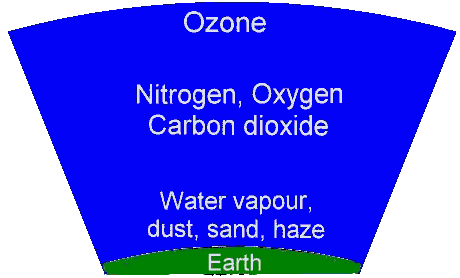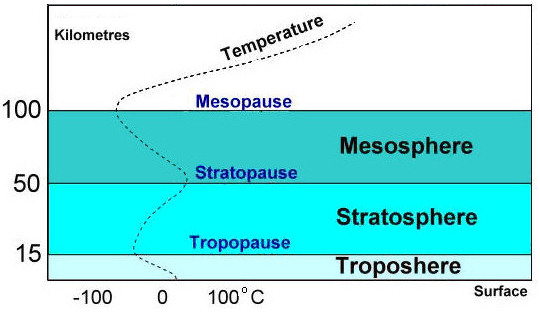The Atmospheric Composition
The Earth's atmosphere comprises a layer of gases retained by the Earth's gravity. It contains roughly 78% nitrogen, 21% oxygen, 0.9% argon, 0.04% carbon dioxide, trace amounts of other gases and a variable amount (average around 1%) of water vapour. This mixture of gases is commonly known as air. The atmosphere protects life on earth by absorbing ultraviolet solar radiation and reducing temperature extremes between day and night.

Atmospheric Composition
The Atmospheric Layers
The atmosphere is divided into three main layers: 1. Troposphere 2. Stratosphere 3. Mesosphere

Schematic diagram of the atmosphere
Troposphere
The troposphere is the lowest layer of the atmosphere. It begins at the surface and extends to between 7 km (23,000 ft) at the poles and 17 km (60,000 ft) at the equator, the variation being due to weather factors. The troposphere has a great deal of vertical mixing due to solar heating at the surface. This heating warms air masses, which makes them less dense so they rise. When an air mass rises, the pressure upon it decreases so it expands, doing work against the opposing pressure of the surrounding air. To do work is to expend energy, so the temperature of the air mass decreases. As the temperature decreases, water vapour in the air mass may condense or solidify, releasing latent heat that further uplifts the air mass. This process determines the maximum rate of decline of temperature with height, called the adiabatic lapse rate.
The tropopause is a boundary region in the atmosphere between the troposphere and the stratosphere. Here the air ceases to cool at -50°C and the air becomes almost completely dry.
Stratosphere
The stratopause is the level of the atmosphere which is the boundary between two layers, stratosphere and the mesosphere.
Mesosphere
The mesosphere extends from about 50 km (160,000 ft) to the range of 80 to 85 km (265,000 – 285,000 ft). Here, temperature decreases with height. Here is also where most meteors burn up when entering the atmosphere.